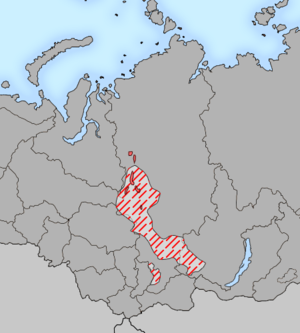
Back Jenisseische Sprachen ALS لغات ينيسية Arabic Llingües yeniseicas AST Yenisey dilləri Azerbaijani یئنیسئی دیللری AZB Енісейскія мовы BE-X-OLD Енисейски езици Bulgarian Yezhoù yenisek Breton Llengües ienisseianes Catalan Jenisejské jazyky Czech
This article has multiple issues. Please help improve it or discuss these issues on the talk page. (Learn how and when to remove these messages)
|
| Yeniseian | |
|---|---|
| Yeniseic, Yeniseyan | |
| Geographic distribution | today along the Yenisei River historically large parts of Siberia and of Mongolia |
| Ethnicity | Yeniseian people |
Native speakers | 156 (2020)[1][notes 1] |
| Linguistic classification | Dené–Yeniseian?
|
| Proto-language | Proto-Yeniseian |
| Subdivisions |
|
| Language codes | |
| Glottolog | yeni1252 |
 Distribution of Yeniseian languages in the 17th century (hatched) and in the end of 20th century (solid). Hydronymic data suggests that this distribution represents a northward migration of original Yeniseian populations from the Sayan Mountains and northern Mongolia. | |
 The distribution of individual Yeniseian languages in 1600 | |

The Yeniseian languages (/ˌjɛnɪˈseɪən/ YEN-ih-SAY-ən; sometimes known as Yeniseic, Yeniseyan, or Yenisei-Ostyak;[notes 2] occasionally spelled with -ss-) are a family of languages that are spoken by the Yeniseian people in the Yenisei River region of central Siberia. As part of the proposed Dené–Yeniseian language family, the Yeniseian languages have been argued to be part of "the first demonstration of a genealogical link between Old World and New World language families that meets the standards of traditional comparative-historical linguistics".[2] The only surviving language of the group today is Ket.
From hydronymic and genetic data, it is suggested that the Yeniseian languages were spoken in a much greater area in ancient times, including parts of northern China and Mongolia.[3] It has been further proposed that the recorded distribution of Yeniseian languages from the 17th century onward represents a relatively recent northward migration, and that the Yeniseian urheimat lies to the south of Lake Baikal.[4]
The Yeniseians have been connected to the Xiongnu confederation, whose ruling elite may have spoken a southern Yeniseian language[according to whom?] similar to the now extinct Pumpokol language.[5] The Jie, who ruled the Later Zhao state of northern China, are likewise believed to have spoken a Pumpokolic language based on linguistic and ethnogeographic data.[6]
For those who argue[when?] the Xiongnu spoke a Yeniseian language, the Yeniseian languages are thought to have contributed many ubiquitous loanwords to Turkic and Mongolic vocabulary, such as Khan, Tarqan, and the word for 'god', Tengri.[5] This conclusion has primarily been drawn from the analysis of preserved Xiongnu texts in the form of Chinese characters.[7]
- ^ 7. НАСЕЛЕНИЕ НАИБОЛЕЕ МНОГОЧИСЛЕННЫХ НАЦИОНАЛЬНОСТЕЙ ПО РОДНОМУ ЯЗЫКУ
- ^ Bernard Comrie (2008) "Why the Dene-Yeniseic Hypothesis is Exciting". Fairbanks and Anchorage, Alaska: Dene-Yeniseic Symposium.
- ^ Vajda, Edward J. (2013). Yeniseian Peoples and Languages: A History of Yeniseian Studies with an Annotated Bibliography and a Source Guide. Oxford/New York: Routledge.
- ^ Vajda, Edward. "Yeniseian and Dene Hydronyms" (PDF). Language Documentation & Conservation Special Publication. 17: 183–201.
- ^ a b Vovin, Alexander (2000). "Did the Xiong Nu Speak a Yeniseian Language?". Central Asiatic Journal. 44 (1).
- ^ Cite error: The named reference
vovwas invoked but never defined (see the help page). - ^ Vovin, Alexander (2020). "Two Newly Found Xiong-nú Inscriptions and Their Significance for the Early Linguistic History of Central Asia". International Journal of Eurasian Linguistics. 2 (2): 315–322. doi:10.1163/25898833-12340036.
Cite error: There are <ref group=notes> tags on this page, but the references will not show without a {{reflist|group=notes}} template (see the help page).